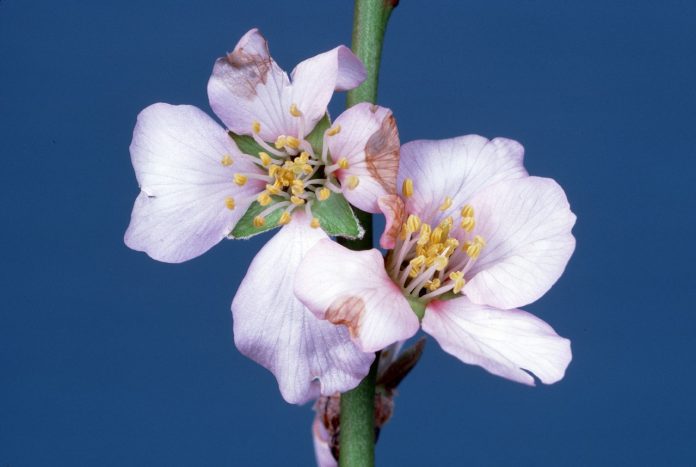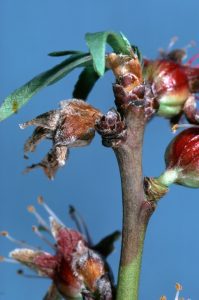
While many Californians are hoping for a wet winter season, there is a window during that time when almond growers would really prefer a dry spell.
Dry weather during and right after bloom reduces the likelihood of serious infection of bloom diseases. Spores are airborne or rain splashed. Infection is favored by rainy weather with temperatures in the mid-70s during bloom. Infections can also occur in dry years with high humidity.
Depending on the level of disease inoculum present in the orchard, moisture and warm temperatures can significantly increase the chances of severe infection which will affect production. Monitoring weather conditions during this critical time and taking timely preventative steps can be the difference between good almond production and devastation.
Pedro Hernandez, product development project manager for Nichino America, said the decision of whether to spray at bloom or not should be based on past experience of infection in the orchard and the chances of a rain event during bloom.
“Don’t gamble. Pay attention to the weather. Be proactive and protect the trees before infection starts if there is rain in the forecast. There is no cure for these diseases,” Hernandez warned.
Almond growers have a narrow window from pink bud to petal fall to prevent outbreaks of bacterial and fungal bloom diseases. Monitoring environmental factors during the critical period, knowing the disease history of specific orchards and understanding what needs to be done to prevent yield losses due to disease are important for almond growers as bloom time approaches.
Brent Holtz, UCCE farm advisor in San Joaquin County, reports that the main fungal diseases in almonds at bloom are Brown Rot Blossom Blight, Green Fruit Rot or Jacket Rot and Shothole. Less prevalent are Scab, Rust, Leaf Blight and Anthracnose. The pathogens that cause these diseases are usually always present in the orchard. Their levels depend on past year’s disease levels. Environmental conditions, temperatures and moisture trigger disease development.
A successful prevention program, Holtz noted, is based on wise choice of fungicides and good timing and coverage.
Hernandez said combination fungicide mixes are commonly used to cover the spectrum of pathogens that cause the diseases.
Brown Rot Formation
Justin Nay, a certified crop advisor and president of Integral Ag, said enough dew formation and warm temperatures can initiate a brown rot outbreak. In dry conditions, the threat of bloom disease can drop off a grower’s radar, he said. Decisions to make a preventative spray application should be based on history of disease and weather predictions. In young orchards where there is no history, treatment can be considered to prevent buildup of disease inoculum.
Growers will be looking at orchard history and calculating if fungicide applications are warranted, Nay predicted, due to costs.
There are specific conditions that favor bloom disease development. For blossom infection to occur at 50 degrees F, 18 hours of leaf wetness is needed. At 68 degrees F, only eight hours of leaf wetness is needed. High humidity also affects disease symptom development. Spore masses can quickly form on diseased flower parts and twig cankers. The stamens and pistils are the most susceptible parts of the flower.
Timing fungicide applications is an important part in preventing brown rot, jacket rot and other fungal diseases, but orchard access due to rain may be an issue. According to UC, brown rot (Monolinia laxa or M. fructicola ) infection timing is from pink bud through petal fall. Full blooms are most susceptible. Favorable conditions include rain or high humidity and dew along with temperatures over 58 degrees F. The most susceptible varieties are Butte, Carmel, Winters and Wood Colony.
Holtz reported that two fungicide applications are normal for brown rot prevention. The first is done at 5% to 20% bloom with a systemic. The second application, a rotation, is at 80% to full bloom or two weeks later. Weather conditions could warrant a third spray if wet weather continues or the two-week protection period has lapsed.
Timing for preventative treatment in dry conditions is a single fungicide application at 20% to 40% bloom.
Jacket Rot
Green fruit rot or jacket rot is caused by the pathogens Botrytis cinerea, Sclerotinia sclerotiorum and Monilinia laxa. Favorable conditions for infection include cool, rainy weather and nut clusters that trap senescing flower parts. Fungicide application timing is at full bloom and when bloom is extended. Nay said the Botrytis pathogen that causes this disease is found everywhere, and this infection can persist beyond bloom. Petals are susceptible as they fall and the pathogen moves into the jackets, damaging the nut embryo.
Shot Hole
Hernandez said shot hole is more of a later bloom disease. This fungal disease infects leaves, fruits and green wood. Leaf infections result in a lesion with a yellow halo. Later in the growing season, the lesion drops and leaves a hold. Severe infections can kill the developing nut or cause deformities.
Moisture and temperatures above 36 degrees F can trigger the disease. In warmer conditions, the fungus can produce spores and infect leaf tissues in less than six hours. Multiple infection cycles can occur within a season due to re-occurring rain events, which can cause severe defoliation.
Hernandez said this disease is more common when significant rain occurs after leaf-out.
The UC IPM guidelines noted life cycle and fungicides for control.
Anthracnose is less common, but outbreaks can cause severe damage, Nay said, citing outbreaks in 2017 and 2019 well after bloom. Warm, wet spring weather can trigger anthracnose. Prevention should begin from pink tip forward to protect blossoms.

Bacterial Disease
Bacterial blast, (Pseudomonas syringe) is a bacterial bloom disease that is low-risk in dry years but can cause significant damage in the right environmental conditions. The UC IPM guidelines report wet and freezing temperatures can trigger outbreaks of bacterial blast. Bacterial blast symptoms are shriveled-up-looking blossoms often on twigs that have died back. Additionally, buds can die, and dieback can occur on larger branches as a result of severe infections.
In 2022, a Section 18 emergency request for use of kasugamycin was granted during a specific time frame in counties that supplied crop loss data. The emergency approval allowed for use of kasugamycin when cold or freezing temperatures are expected at a use rate of 64 fluid ounces in at least 100 gallons of water by ground application.
Honeybee protection is always a concern with fungicide applications during bloom, Hernandez said. Reading and following the fungicide label and understanding the toxicity to foraging bees is advised. Applications should always be done late afternoon when bees are not actively foraging.

Cecilia Parsons
Cecilia Parsons has lived in the Central Valley community of Ducor since 1976, covering agriculture for numerous agricultural publications over the years. She has found and nurtured many wonderful and helpful contacts in the ag community, including the UCCE advisors, allowing for news coverage that focuses on the basics of food production.
She is always on the search for new ag topics that can help growers and processors in the San Joaquin Valley improve their bottom line.
In her free time, Cecilia rides her horse, Holly in ranch versatility shows and raises registered Shetland sheep which she exhibits at county and state fairs during the summer.















